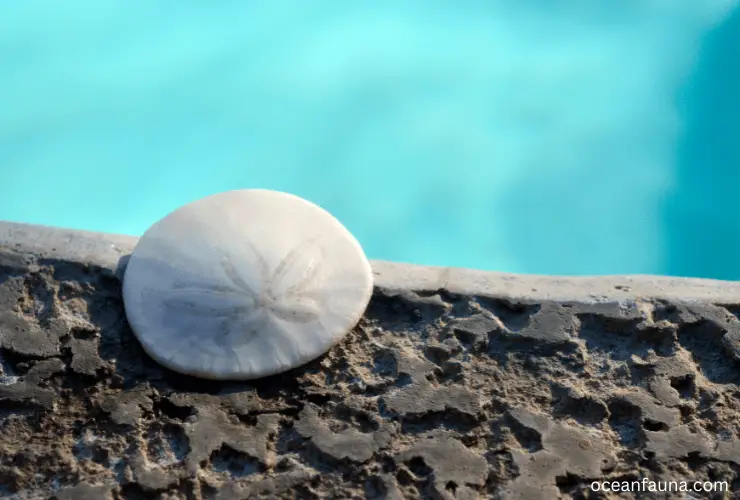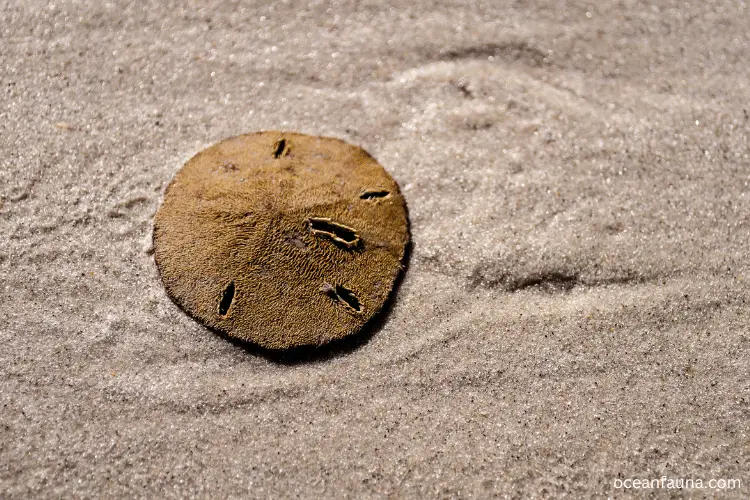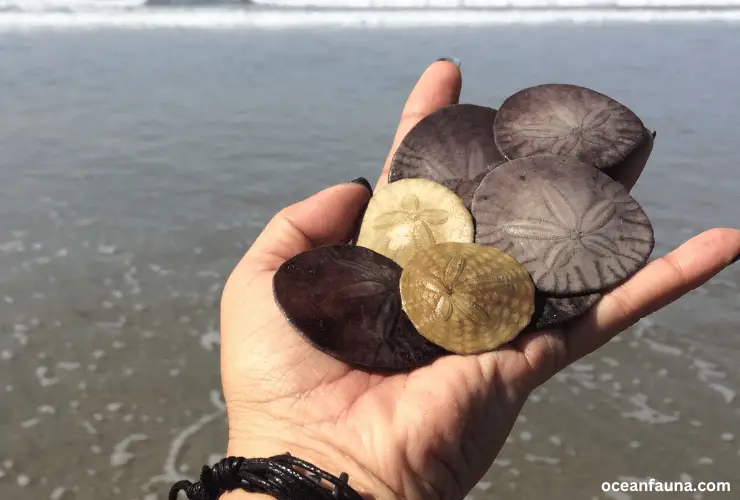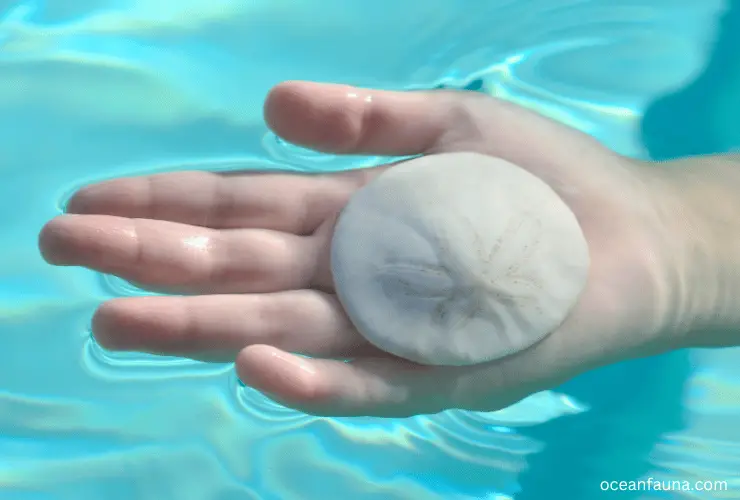How big do sand dollars get? Sand dollars mostly have a 5 to 10 cm diameter. The biggest sand dollar was found in 2013. It measured 6.29 inches at its maximum diameter and 5.8 inches at its smallest diameter.
They mostly grow during the juvenile stage of their life cycle. However, another sand dollar with a 6.5 inches diameter has recently been found.
Sand dollars are small echinoderms with no backbone and developed systems to provide support. Therefore, they are small in size. Moreover, they have a short lifespan of 6 to 10 years. Now, let’s get into the article, and unravel some fascinating truths about these minute sea biscuits!
How Big Do Sand Dollars Get?
How big does a sand dollar get? A sand dollar mostly attains a size of two to four inches in diameter (5 to 10 cm) and weighs nearly one ounce.
Moreover, they are incredibly lightweight, weighing less than even an ounce. Here is table on the sizes of some most common sand dollars
| Species | Average Diameter (cm) |
| Echinarachnius parma | 5 – 10 |
| Dendraster excentricus | Up to 8 |
| Mellita quinquiesperforata | 7.5 – 15 |
| Leodia sexiesperforata | Up to 10 |
| Clypeasteroida | Up to 3.94 |
The Phase of Life: Sand Dollars Grow
During which phase of life do sand dollars grow? Sand dollars undergo most of the growth and development during the larvae and juvenile phases of their life. When a sand dollar exists as larvae, it grows eight arms in nearly six weeks. However, it is still less than 0.03 inches by that time.
Most of the increase in size is observed in the juvenile phase. Here, the sand dollar undergoes metamorphosis for nearly 90 minutes. Later, it grows in size and develops various organs, including spins, mouth, anus, etc. In short, the juvenile is categorized as the ultimate phase of growth.

What Is the Biggest-Sized Sand Dollar in The World?
According to the 2013 Guinness Record, United States, the largest sand dollar was founded by Dan Manna in Florida, USA, on May 13.
The sand dollar weighed 5.4 oz (0.153 kilograms) and was measured to be
Recently, local Blake Dumas claimed to find a sand dollar that surpasses the world record. They found it in Joe’s Beach. It has a diameter of 6.5 inches. However, Guinness hasn’t posted it yet in the world record list.
What Is the Smallest-Sized Sand Dollar in The World?
Till date, there is no evidence that suggests the smallest size of adult sand dollars. But, a 3 month old sand dollar can be around 0.2 cm in size which is the maximum size of a grain of sand.
How Big Do Baby Sand Dollars Get?
Sand dollars start their journey as tiny eggs that are fertilized in the water. From that moment on, it takes approximately three months for the eggs to develop into young sand dollars.
Despite being three months old, young sand dollars are still very small. They are barely bigger than a grain of sand and only measure around 0.06mm to 2.0mm in diameter. However, as they continue to grow and mature, sand dollars can reach various sizes, depending on the species.
Size of Sand Dollars: Our Finding Last Year

Last year, my friends and I visited Florida’s Sanibel Island and spent a day at the beach. While walking along the shoreline, we found several dead sand dollars of different sizes and shapes. It was intriguing to see them in their natural habitat.
Most of them have an average size of 6 cm – 7 cm. But surprisingly, we also found a few that were around 10 cm – 12 cm in diameter. We were amazed to see how big they can get.
Why Are Sand Dollars Smaller in Size?
Sand Dollars, being invertebrates, are quite small. The reason is their less developed skeletal system. They have weak muscles with no backbone and bony skeletons. As a result, it has no effective way or adaptation to support the large skeleton.
Therefore, they prefer to remain small in size. It helps them:
What Is the Composition of Sand Dollars?
Sand Dollars are composed of a hard five-fold calcium carbonate shell. It helps protect the organism from harsh environmental challenges.
The shell is covered with cilia, pedicellariae, and tube feet that play a role in locomotion and capturing food. Inside the shell, there are five dove-shaped teeth. They are known for grinding food.
Moreover, they have a separate mouth and anus opening for food intake and waste product excretion.
Do Sand Dollars Undergo Ecdysis?
No! Sand dollars don’t undergo ecdysis to remove their exoskeleton or shell. Instead, the test collects minerals from the surrounding water and grows in size.
In fact, no echinoderm undergoes the process of molting or ecdysis. Instead, arthropods undergo this phenomenon to shed their exoskeleton and grow a new one of relatively large size.
Why Do Sand Dollars Grow in Clusters?

Sand dollars prefer to grow in groups or clusters called Purses. Usually, 625 sand dollars live in 1 square yard together. This primarily increases their rate of fertilization.
Sand dollars reproduce externally. So, they prefer to live in close groups so that maximum sperm can fertilize eggs, resulting in a new baby sand dollar. However, they don’t live in colonial form and, therefore, don’t practice division of labor.
Are Sand Dollars Longitudinal or Symmetrical?
Sand Dollars show both radial and bilateral symmetry. They exhibit secondary bilateral symmetry in the front-to-back direction in the larva stage. You can get two equal parts by dividing them along the anterior-posterior plane.
However, when they are adults, they have a five-petal-shaped skeleton. Therefore, they exhibit five-fold radial symmetry. You can divide them at any plane passing through the central axis and get two mirror-image halves of sand dollars.
How Long Do Sand Dollars Take to Grow?
Sand dollars take nearly 12 weeks (3 months) to grow and become an adult. Once fertilized, a baby sand dollar takes six weeks to develop its eight- arms plexus. Later, it undergoes metamorphosis and completes the remaining development in 7 to 8 days. However, they attain sexual maturity at the age of 4.
FAQs
How do sand dollars reproduce?
Sand Dollars reproduce both sexually and asexually. It undergoes sexual reproduction by broadcast spawning. On the other hand, it reproduces asexually by cloning.
How to find the age of sand dollars?
You can find the age of sand dollars by counting the number of rings present on their exoskeleton. They also grow rings every year like trees.
Why do sand dollars grow small during the larvae stage?
Sand dollars divide themselves in the larvae stage by cloning. They undergo cloning to reduce themselves in size. It helps them escape from the eye of predators.
Where do sand dollars live?
Sand Dollars live in the lower tidal zone of the ocean. However, you can find them along the seashore and coastal line after a low tide in the morning and evening.
Conclusion
Sand dollars are small marine animals. They usually have a small size, between two to four inches. However, sand dollars with diameters up to 6.29 and 6.5 inches have been found.


3 thoughts on “How Big Do Sand Dollars Get?”